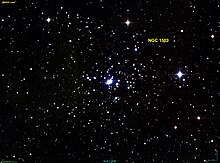 The location of NGC 1502 (circled) | |
| Observation data (J2000 epoch) | |
|---|---|
| Right ascension | 04h 07m 48.96s[1] |
| Declination | +62° 19′ 55.2″[1] |
| Distance | 3,452 ly (1,058.4 pc)[1] 3,643+313 −290 ly (1,117+96 −89 pc)[2] |
| Apparent magnitude (V) | 6.0[3] |
| Apparent dimensions (V) | 9.7′[1] |
| Physical characteristics | |
| Radius | 5.5 ly (1.7 pc)[4] |
| Estimated age | 5 Myr[2] |
| Other designations | NGC 1502,[5] Cr 45 |
| Associations | |
| Constellation | Camelopardalis |

NGC 1502 (also known as the Golden Harp Cluster[6]) is a young[7] open cluster of approximately 60[3] stars in the constellation Camelopardalis, discovered by William Herschel on November 3, 1787.[8] It has a visual magnitude of 6.0 and thus is dimly visible to the naked eye.[3] This cluster is located at a distance of approximately 3,500 light years[1][2] from the Sun, at the outer edge of the Cam OB1 association of co-moving stars, and is likely part of the Orion Arm.[2] The asterism known as Kemble's Cascade appears to "flow" into NGC 1502, but this is just a chance alignment of stars.[9]
The Trumpler class of NGC 1502 is II3p, indicating poorly populated cluster of stars (p) with a wide brightness range (3). The main sequence turnoff point is not well-defined, so the age estimates range from five to fifteen million years.[7] It is heavily reddened due to interstellar dust.[4] One of the brightest candidate members of the cluster is the eclipsing binary SZ Cam, which is a component of a visual double star ADS 2984.[2] There are eleven variable stars and four candidate variables among the cluster members, including a β Cep, two periodic B-type variables, 2–3 eclipsing variables, and an RR Lyrae star.[7] Five members of the cluster are chemically peculiar.[10]
See also
[edit]- Alpha Camelopardalis, a runaway star possibly ejected from this cluster.[7]
References
[edit]- ^ a b c d e Cantat-Gaudin, T.; Anders, F. (January 2020). "Clusters and mirages: cataloguing stellar aggregates in the Milky Way". Astronomy & Astrophysics. 633: 22. arXiv:1911.07075. Bibcode:2020A&A...633A..99C. doi:10.1051/0004-6361/201936691. S2CID 208138247. A99.
- ^ a b c d e Topasna, G. A.; et al. (August 2018). "Interstellar polarization and extinction towards the young open cluster NGC 1502". Astronomy & Astrophysics. 615: 16. Bibcode:2018A&A...615A.166T. doi:10.1051/0004-6361/201731903. A166.
- ^ a b c O'Meara, Steve (2007). Herschel 400 Observing Guide. Cambridge University Press. p. 35. ISBN 9780521858939.
- ^ a b Tripathi, A.; et al. (September 2013). "Photometric study of Galactic open cluster NGC 2129, NGC 1502 and King 12". Bulletin of the Astronomical Society of India. 41 (3): 209. Bibcode:2013BASI...41..209T.
- ^ "NGC 1502". SIMBAD. Centre de données astronomiques de Strasbourg. Retrieved 2022-01-10.
- ^ Stoyan, Ronald; Schurig, Stephan (2014). interstellarum Deep Sky Atlas. Erlangen: Cambridge University Press; Oculum-Verlag GmbH. ISBN 978-1-107-50338-0. OCLC 920437579.
- ^ a b c d Michalska, G.; et al. (December 2009). "A CCD Search for Variable Stars of Spectral Type B in the Northern Hemisphere Open Clusters. VII. NGC 1502". Acta Astronomica. 59 (4): 349–370. arXiv:0910.3672. Bibcode:2009AcA....59..349M.
- ^ Seligman, Courtney. "Celestial Atlas: NGC Objects: NGC 1500 - 1549". cseligman.com. Retrieved 2022-01-10.
- ^ Thompson, Robert; Thompson, Barbara (2007). Illustrated Guide to Astronomical Wonders, From Novice to Master Observer. O'Reilly Media. p. 111. ISBN 9780596526856.
- ^ Paunzen, E.; et al. (November 2005). "CCD photometric search for peculiar stars in open clusters. VI. NGC 1502, NGC 3105, Stock 16, NGC 6268, NGC 7235 and NGC 7510". Astronomy and Astrophysics. 443 (1): 157–162. arXiv:astro-ph/0508151. Bibcode:2005A&A...443..157P. doi:10.1051/0004-6361:20053287. S2CID 17585037.
External links
[edit] Media related to NGC 1502 at Wikimedia Commons
Media related to NGC 1502 at Wikimedia Commons- NGC 1502 on WikiSky: DSS2, SDSS, GALEX, IRAS, Hydrogen α, X-Ray, Astrophoto, Sky Map, Articles and images
Well, that’s interesting to know that Psilotum nudum are known as whisk ferns. Psilotum nudum is the commoner species of the two. While the P. flaccidum is a rare species and is found in the tropical islands. Both the species are usually epiphytic in habit and grow upon tree ferns. These species may also be terrestrial and grow in humus or in the crevices of the rocks.
View the detailed Guide of Psilotum nudum: Detailed Study Of Psilotum Nudum (Whisk Fern), Classification, Anatomy, Reproduction